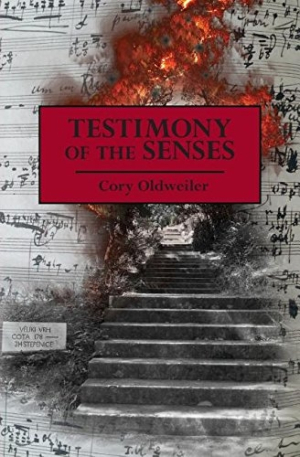Testimony of the Senses
Testimony of the Senses is passionately written with a vivid roster of characters.
Cory Oldweiler’s Testimony of the Senses weaves an engrossing tale threaded with music and mythology.
For young Emilio Tramonti, life begins without his father, who presumably died months before Emilio’s birth in 1957. Emilio’s childhood is somewhat insular, limited for the most part to the neighborhood surrounding his mother and grandparents’ home and bakery in Corona, Queens. Bullied at school, Emilio escapes to the wider world of his own precocious intelligence and imagination.
Emilio’s friendship with the Polish refugee Jerzi, a violinist who claims to play with the New York Philharmonic, is also precocious and unusual. Jerzi appeals to Emilio as a father figure and fosters the boy’s love of classical music. But the anguish of World War II has taken its toll on Jerzi, who struggles with alcoholism and whose orchestral career turns out to be rather exaggerated.
Oldweiler skillfully conveys Emilio’s sense of outrage when he discovers that Jerzi is less than he pretends to be. Emilio, now a teenager going by the nickname Milo, is still too young to comprehend the heaviness of circumstance that might lead a man to lie about how he earns a living, and he remains angry and unforgiving. This betrayal, along with the shocking discovery that his real father, Carlo, is still alive, propels Milo into chaotic freedom and the cityscape beyond Queens. Having been rejected and abandoned by Carlo, Milo is determined to find him and to forge his own new identity.
Testimony of the Senses is passionately written with a vivid roster of characters. There are occasional drifts into abstruse prose, but the narrative remains true to the nature of the novel’s troubled, brilliant protagonist. Emilio, who first becomes Milo and then later Miles, is almost painfully perceptive and bright. Rather than listening to Top 40 radio like most of his peers, Milo is instead fascinated by composer Gustav Mahler. By age seventeen, Milo is forced into wily independence and knowledge far beyond his years.
Seen through Emilio/Milo/Miles’ prismatic mind, Oldweiler’s Manhattan backdrop is rich with details of the era, such as Leonard Bernstein’s Concerts for Young People, subway rides to Carnegie Hall, and going to the Metropolitan Opera, with its “deep-red walls” and sparkling Swarovski chandeliers. These cultural aspects offer a fine contrast to grittier moments of 1970s New York, like crime waves, heat waves, blackouts, and budget cuts.
The need to know more about the enigmatic Carlo becomes all-consuming for his son, leading him to Europe where Carlo, like Jerzi, was deeply affected by World War II. By making Carlo an army photographer, the author offers a visual trail of memories and gives Carlo a sympathetic edge, as his wartime experiences are not only physical, but also on film and forever in focus. Rootlessly persistent, Emilio/Milo/Miles must be “both explorer and cartographer” as he retraces his father’s odyssey and pursues Testimony of the Senses’ harrowing quest.
Reviewed by
Meg Nola
Disclosure: This article is not an endorsement, but a review. The publisher of this book provided free copies of the book and paid a small fee to have their book reviewed by a professional reviewer. Foreword Reviews and Clarion Reviews make no guarantee that the publisher will receive a positive review. Foreword Magazine, Inc. is disclosing this in accordance with the Federal Trade Commission’s 16 CFR, Part 255.

